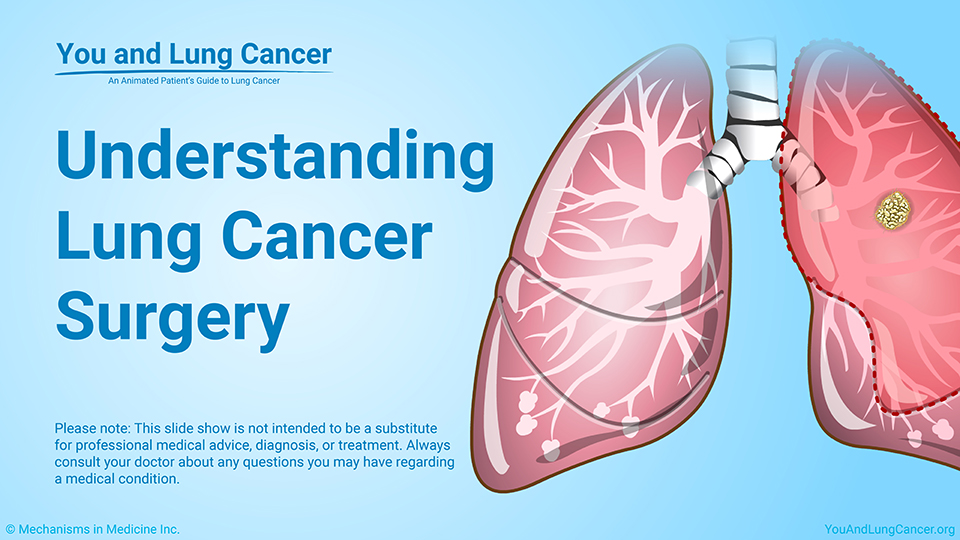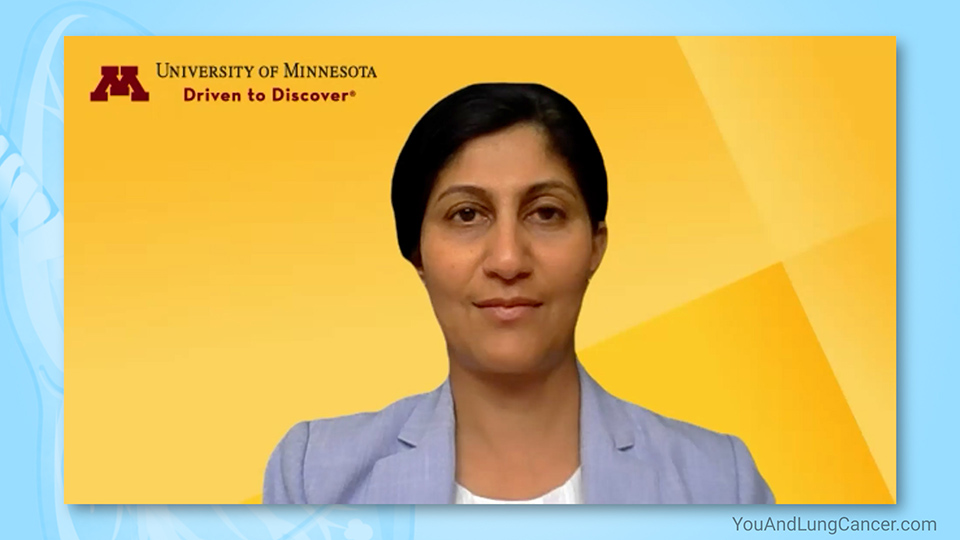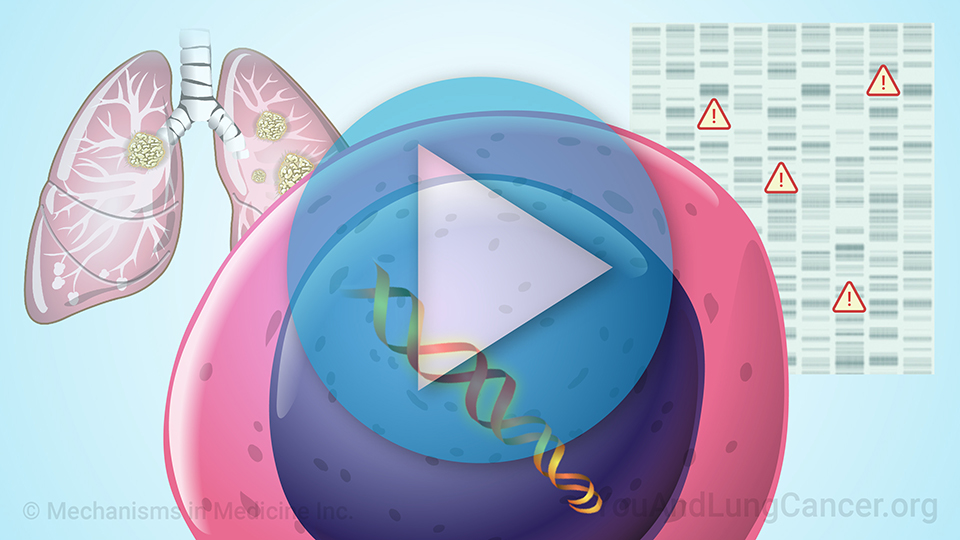Understanding Lung Cancer Surgery
*Please note: This slide show is not intended to be a substitute for professional medical advice, diagnosis, or treatment. Always consult your doctor about any questions you may have regarding a medical condition.
Surgery for lung cancer
Surgery is a treatment option for some people with lung cancer. Your doctor may recommend surgery if the cancer is relatively small, has not spread, and can be removed fairly easily.
Surgery for lung cancer
Surgery may also be done to help diagnose or stage lung cancer, by removing tissue or lymph nodes for examination.
Treating lung cancer with surgery
Surgery is rarely done to treat small cell lung cancer (SCLC), as this type has usually spread by the time doctors find it. A few people with SCLC may have surgical treatment.1
Surgery is more commonly used to treat non-small cell lung cancer (NSCLC). The best outcomes are for early-stage cancers, but surgery may be combined with other treatments later. It can also be done to relieve lung cancer symptoms.2
When is surgery not an option?
Surgery may not be an option if the cancer is advanced or has spread to other parts of the body, or if your general health, age, or another lung condition make surgery too risky.
Lung cancer surgery is a demanding procedure
Lung cancer surgery is a demanding procedure. Recovery can take several weeks to months. Your doctor will talk with you about all your treatment options.3
How lung cancer surgery is done: Minimally invasive surgery (thoracoscopy)
Lung cancer surgery is often done with small incisions and video cameras, for faster recovery and less discomfort after surgery. This type of surgery is called minimally invasive. Options include:
-
Video-assisted thoracic surgery (VATS) which uses small incisions and a tiny camera.
-
Robotic-assisted thoracic surgery (RATS) which is done with extremely precise robotic tools.1,3,4
How lung cancer surgery is done: Open surgery (thoracotomy)
Open surgery, called thoracotomy, requires a larger incision. It may be done for larger tumors or more complex cancers. Open thoracotomy involves a longer recovery but is sometimes necessary for the best outcome.1,3
Types of lung cancer surgery
However your surgery is done, it will remove all or part of a lung. Different types of lung cancer surgery are:5
-
A pneumonectomy, which removes a whole lung.
-
A lobectomy, which removes one of your lungs' five sections (lobes).
-
A segmentectomy, which removes part of one lobe.
-
A sleeve operation, which removes part of an airway together with a section of the lung.
Your surgery type will depend on the tumor size, its location, and your lung function.
Your lung cancer surgery team
If you have lung cancer surgery, you should know that it is most likely to be successful at a cancer center with experienced surgeons. In the United States, look for centers accredited by the American College of Surgeons that specialize in lung cancer. The National Cancer Institute also has a list of specialty centers.6
Your team will also include surgical oncologists, anesthesia specialists, nurses, and rehabilitation experts.
Preparing for lung cancer surgery
It's also important to prepare for lung cancer surgery. This is called prehabilitation and increases the chance of a good outcome. It can include breathing exercises, general fitness, good nutrition and stopping smoking, if you smoke. Your surgery team will help you prepare.
Surgery and other lung cancer treatments
Lung cancer surgery can be combined with other treatments.1-3 Treatment before surgery is called neoadjuvant therapy. It can help shrink tumors to make surgery more successful.
Treatment after surgery is called adjuvant therapy. It can help keep the cancer from returning and improve long-term survival.
Biomarker testing is required to determine eligibility and to guide the selection of neoadjuvant and adjuvant therapies.
What to expect from lung cancer surgery
Lung cancer surgery is done with general anesthesia. You will be deeply asleep and not aware of the procedure.
How long the surgery takes depends on what type of surgery you have. After surgery, recovery is usually shorter after minimally invasive surgery than open surgery.
Your surgery team monitors you closely through and immediately after surgery.
After your lung cancer surgery
Your hospital stay will be shorter if you have minimally invasive surgery. It may be just a few days, compared to longer after open surgery.
After your lung cancer surgery
Enhanced recovery after surgery (ERAS) is a way to help reduce pain and speed up recovery. ERAS protocols include advanced pain management techniques that reduce your need for strong pain medications.
Your path forward after lung cancer surgery
Especially when done early, lung cancer surgery can be a good treatment option. With the right surgery team and approach, many people can live full, active lives after surgery.
Advanced technology and minimally invasive techniques are also making lung cancer surgery recovery easier while maintaining good outcomes.
Early detection and treatment for the best outcomes
For lung cancer, early detection and treatment make a difference.
If you're at risk for lung cancer, talk to your doctor about screening.
If you've been diagnosed, talk to your doctor about biomarker testing for optimal treatment.
Early detection and waiting for biomarker test results before a treatment plan gives you the best chance of a positive outcome.
References
- American Cancer Society. Surgery for small cell lung cancer. Last revised: January 29, 2024.
https://www.cancer.org/cancer/types/lung-cancer/treating-small-cell/surgery.html
- American Cancer Society. Treatment choices for non-small cell lung cancer treatment by stage. Last revised: June 23, 2025.
https://www.cancer.org/cancer/types/lung-cancer/treating-non-small-cell/by-stage.html
- American Cancer Society. Surgery for non-small cell lung cancer. Last revised: January 29, 2024.
https://www.cancer.org/cancer/types/lung-cancer/treating-non-small-cell/surgery.html
- American Lung Association. Minimally invasive thoracic surgery. Last revised: November 20, 2024.
https://www.lung.org/lung-health-diseases/lung-procedures-and-tests/minimally-invasive-thoracic-surgery
- Hoy H, Lynch T, Beck M. Surgical treatment of lung cancer. Crit Care Nurs Clin North Am. 2019 Sep;31(3):303-313.
- Eldridge L. Tips for choosing a lung cancer treatment center. Verywell Health. Last revised: November 25, 2024.
https://www.verywellhealth.com/choosing-a-lung-cancer-treatment-center-2248917
- Kodia K, Alnajar A, Szewczyk J, Stephens-McDonnough J, Villamizar NR, Nguyen DM. Optimization of an enhanced recovery after surgery protocol for opioid-free pain management following robotic thoracic surgery. JTCVS Open. 2022 Jan 25;9:317-328.
This slide show provides an
overview of lung cancer surgery, including who may be eligible,
what to expect before,
during, and
after surgery, the
different types of surgery,
rehabilitation, and more. You can also learn about surgery and other lung cancer treatments (
neoadjuvant and
adjuvant therapy), and
enhanced recovery after surgery (ERAS). Especially when done early, lung cancer surgery can be a good treatment option. Click through to learn how with the right surgery team and approach, many people can live full, active lives after surgery.
-
Share with family and friends:
Click here to take our SURVEY
Your feedback is important to us! We will use your feedback to develop future areas of content about lung cancer which will help other patients, caregivers and families.



































































